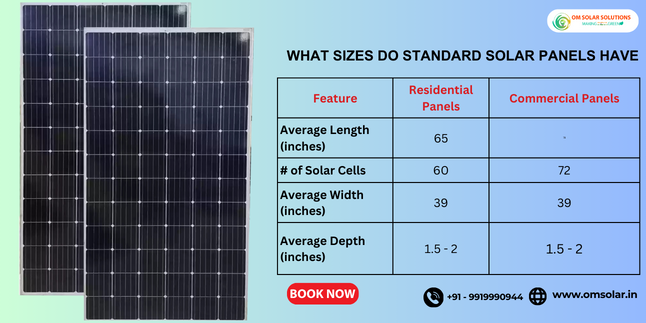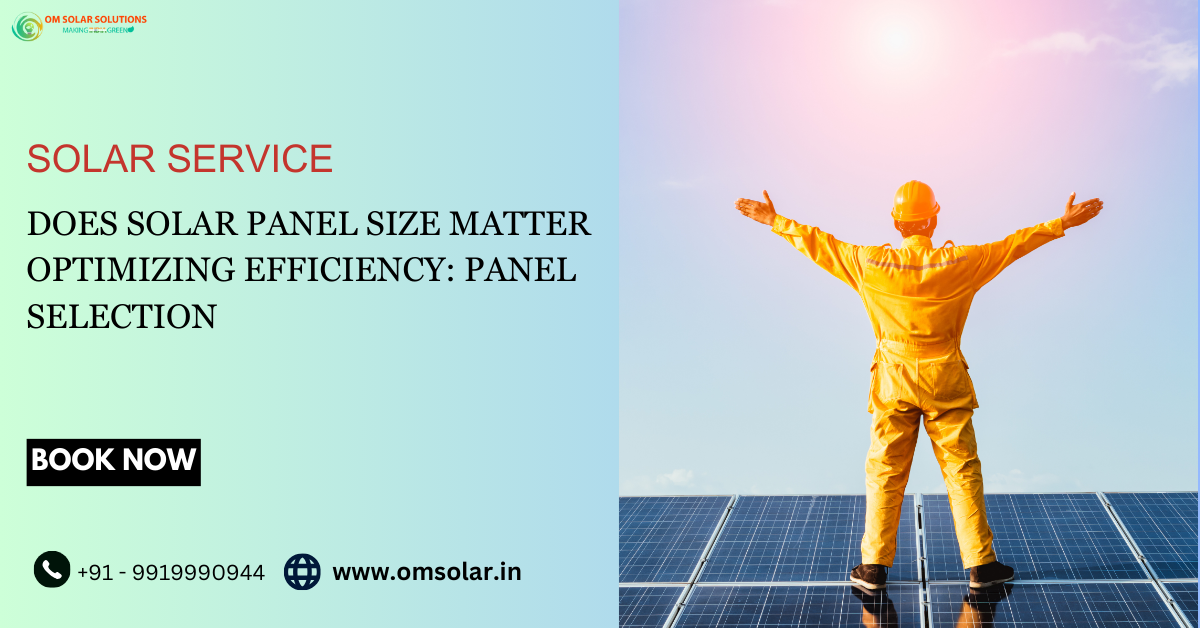Size matters when buying and installing Rooftop Solar panels in Lucknow. Due to sun energy and cell usage discrepancies. Solar panels have solar cells connected by silver wires because silver conducts electricity best.
Size can be measured in numerous ways. Solar panels vary in size, measured in square feet or roof space. Another size indicator is the power rating. Physically larger panels do not necessarily have higher power ratings.
Also Read: 2 kW Solar System Price in Lucknow, UP
Size matters in solar panels, but most homeowners choose a system based on efficiency and reliability. As solar energy technology evolved, panels became smaller and collected more sunlight to generate more electricity.
Benefits of Larger Solar Panels.
A larger panel yields superior results. This statement is commonly heard and is also applicable to solar panels. Sizeable solar panels provide a substantial amount of solar energy, which can be harnessed to generate supplementary power. Commercial establishments, such as industrial enterprises and other expansive open areas, generally implement extensive solar systems, whereas residential solar systems tend to be smaller or of medium size.
There is a legitimate rationale for doing this, which is to increase power use to ensure a consistent supply. Here is the remaining rationale for installation from the solar company in Haryana.
- The wattage per square meter is quite elevated.
- Enables expedited installation.
- Sizable quantities of solar energy can be stored, transformed, and generated.
- Typically, larger panels tend to be more recently produced compared to smaller panels.
- More precisely, reduce the expenses associated with the installation of a solar panel.
While huge solar panels have some advantages, they also come with disadvantages.
- Installation and measurement are challenging.
- The equipment’s weight poses a possible hazard during installation.
- If there is a sudden failure, the price of replacing the item may be significant.
- In addition to the dimensions of the solar panels, choosing panels with higher efficiency is a crucial factor to take into account.
Efficient solar cells ensure both high electricity output and extended operation cycles. In the present day, all prominent brands prioritize the EPC (Engineering, Procurement, and Construction) and I&C (Installation and Commissioning) services, which ultimately enhance the efficiency of solar panels.
Currently, most solar panels available for purchase exhibit an efficiency ranging from 15 to 20 percent. The specific type of solar panel significantly influences this level of efficiency.
The Positive Impact of Efficiency
This enhancement in solar panel efficiency has made the technology increasingly attractive to homes. In the past, when solar panels had lower efficiency, larger panels were required to substantially decrease or eliminate the amount of electricity that homeowners bought from the utility company.
The limited roof space hindered numerous homeowners from installing an adequate number of these bulky and inefficient panels to produce sufficient power, resulting in an insufficient reduction in their electricity expenses to justify the investment in solar energy.
Thanks to the substantial enhancement in efficiency, homeowners now have the option to purchase fewer, physically smaller panels that nonetheless generate the same amount of electricity as previous systems composed of larger panels. Consequently, there are several consequences, but the most notable one is that due to the reduced number of panels required, the homeowner can get a far faster return on investment.
The reduction in roof space required by utilizing fewer panels offers numerous advantages beyond only the financial return on investment. The extra space allows homeowners to install one or more panels, which can generate sufficient electricity to offset additional energy expenses such as a heated pool or electric vehicle. Certain households may choose to install one or more extra panels in anticipation of future rises in energy consumption, such as when a kid returns from college or an elderly parent moves in.
In the past, it was not possible to achieve this since it would have required a large number of inefficient solar panels to satisfy your basic needs, which would have taken up an entire roof.
Homeowners who prioritize aesthetics may prefer a smaller, inconspicuous system. As smaller systems become more efficient, they can now be installed in roof locations that were previously unsuitable for bigger systems. As a result, they can be concealed or installed on a roof that is not visible. Therefore, a compact and discreet yet highly effective system can allow homeowners who wish to keep their devices unnoticed to conceal them and disregard their presence.
What Sizes Do Standard Solar Panels Have?

Residential solar panels with a surface area of 15 square feet are typically 65 inches by 39 inches, or 5.4 feet by 3.25 feet, and would be installed on the roof of your home.
A few minor measurement discrepancies are depending on the manufacturer of the solar panel.
- For large-scale solar installations, such as those attached to warehouses (known as commercial solar panels), solar panels can be up to 6 feet long.
- To estimate the size of a solar panel, the overall structure of the panel must first be established.
- Solar panels are constructed from smaller individual photovoltaic (PV) sun cells. The fixed standard size for PV cells is 156 mm by 156 mm, or approximately 6 inches long and 6 inches wide.
- Most small-scale solar installations, such as the one you’re likely to purchase for your home, are made up of 60 solar cells.
- Commercial solar systems, on the other hand, typically have at least 98 cells and up to 72 cells.
| Feature | Residential Panels | Commercial Panels |
| Average Length (inches) | 65 | 78 |
| # of Solar Cells | 60 | 72 |
| Average Width (inches) | 39 | 39 |
| Average Depth (inches) | 1.5 – 2 | 1.5 – 2 |
How does a standard solar panel (65 inches by 39 inches) translate to a full-sized rooftop solar panel system?
Consider a system with a capacity of 6 kW (kW). Installing a 6 kW system with 20 average-sized panels results in a system that is 352 square feet in total, measuring around 27 feet wide by 13 feet long. This suggests that there are no obstacles on your roof and that your panels can be placed close together; nevertheless, due to the unique form and orientation of your roof, you’ll usually require a little additional area.
The design of your solar panel system significantly impacts the cost of solar; a simpler, more compact installation will almost always be less expensive.
Is your roof able to Sustain the Weight of a Solar Panel Installation?
Knowing the size and weight of each home solar panel installation system allows you to estimate the total weight of a solar panel system. You can use this information to decide whether your roof is suitable for such a system.
Read More: How Much Does It Cost To Install Solar Panels In India, 2023
In a 20-panel, 6-kilowatt solar system (20 panels x 40 lbs), the panels alone weigh around 800 pounds. According to our number above, a similar system weighs 2.3 pounds per square foot (800 pounds divided by 352 sq ft), indicating its size is 352 square feet. When the mounting hardware and other panel-related equipment are included, the weight per square foot will be closer to 3-4 pounds.
Roofs in most modern homes can withstand significantly more weight per square foot than 3 pounds. However, if you have an older roof or are unsure whether it can support the added weight of solar panels, see a roofing specialist. A basic roof examination can help you determine whether putting solar panels on your roof might benefit your home.
Summary
The size of solar panels is important, although larger panels are not always better. You want a panel with a greater power rating and a smaller physical size to give more power in less area. The more efficient and tiny solar panels that are developed, the more power they can produce with less space, the more appealing they will be, and the less strain they will put on rooftops. This trend will continue as solar technology progresses. Now you can choose the right solar panel system and learn about solar energy. Always compare offerings to evaluate which supplier is more convincing. Our Om Solar energy company in Lucknow team can provide free quotations for this task. Different providers will approach you with their offers, and you can choose one.

